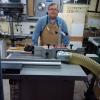I'm a beginner that is building out a work space in a garage (the space is shared with vehicles). After putting together my HF dust collector, I quickly realized that both available circuits in the garage are 15 amps and the DC pulls 20.
I obviously need to get more power into the garage. I'm far from an expert on electricity and I'm looking at a few different options:
1) Verify that all the wiring is 12 gauge and swap the circuit breakers to 20 amp
2) Run one (or more?) 20 amp circuits into the garage from main panel (or should that be 30 amps?)
3) Have a sub-panel installed in the garage (100 amp?)
The sub-panel would be best, but also the most expensive. I'd plan on having an electrician do any of the above.
Any recommendations or different suggestions?
Additional details in case they are relevant:
I currently have a 240V/50amp line going to the garage for charging an electric car
Current tools:
15amp table saw
15amp miter
15amp benchtop planar
10amp benchtop jointer
20amp HF DC
Because the space also functions as a garage, mobility is important. I don't see the ability to move to "real" jointer/planars in this space. I may eventually upgrade to a 220V table saw, but I'd be able to use the existing car outlet for that.
Thanks in advance for thoughts.




 Reply With Quote
Reply With Quote




